Blog
Finding The Old Bones
Note: The social isolation of the Corona Virus has grounded me from making any trips around Texas. The blog below is from a previous trip to Bastrop, Texas and was written by my son, who with me, went on a search for our Texas ancestors' burial plots. It seems to be a basic human need to discover our forefathers, Being able to stand in front of a grave that holds the bones of a family member from generations prior, is a humbling experience. Hope you enjoy the blog.
(Click on pictures to view larger images)
When discussing family histories, talk tends to settle on age-old deeds, exploits and sometimes "who came over when" and where they were from. I've enjoyed these stories for many years and have always been glad for the nearly countless hours I spent with grandparents and great grandparents who clearly remembered - with a storyteller's mind for detail - the sometimes unexpected events of a daily world that had already become extinct in their times. But beyond and beneath that, I've always primarily wanted to know where the bones are. The final resting places of those who were the source points for our family history have been of interest to me more than to the others of my generation or to the one which has now stepped in to someday render my own world extinct.
My mother is now the only member of her family still here, and as such the only fountain of information remaining, and while I know where the graves of our shared extended family are buried, there were several graves I couldn't find on my own and others we believed were hopelessly lost to time. I always knew my great grandmother had been born in and grew up in the Bastrop area and was told that her grandfather had come to Texas from Germany several long decades back - in 1841 according to immigration records - but I had little more knowledge than that and no hope of ever being able to touch this distant branch of the family tree. It was assumed those earliest graves were long-lost in small, forgotten country cemeteries now covered by time, brush and ivy, or else simply developed over.
Following a few recent trips to the COTA racetrack near Bastrop, the discussion of our Smithville/Bastrop roots resurfaced after a lengthy dormancy. The names of our earliest Texas ancestors resided safely in my mother's strong memory - names of great, great grandparents she'd never known. Names of those whose bones formed the basis of several intertwining family trees still residing here today. As with other members of our family, we knew of some of their deeds and adventures and something of their long-obsolete daily lives, but it was only a matter of time before I again wanted to know "where the bones were." Without the bones, there is no real connection to them for me. No one had ever tried to track down the graves of these original Texas kin, likely since it had never seemed possible.
The internet, however, eventually yielded promising results. Find A Grave - a data sharing site providing information gathered by amateur gravetrackers and archivists - contained a small photo of the actual grave of Christian Brinkman, a German from Westphalia who arrived in Texas back when it was still a Republic. We now knew where he and his wife Dorothea were buried - Fairview Cemetery in Bastrop. What we didn't know, and what the cemetery staff couldn't provide us, was the location of either grave within the cemetery. Their records simply don't go back that far. All they could really do was wish us luck.
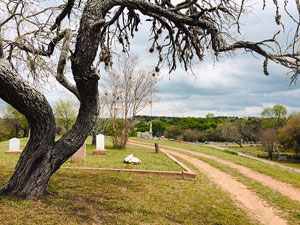 I learned from further research that the cemetery was founded - like many of the day - at the top of a tall hill. Cemeteries of that era were usually placed on hilltops for strategic reasons, namely to provide for vigilance against Indian attacks at a time when unrest and raids were common throughout the West and Near West. All of the oldest of the grave markers at Fairview face in the same direction to allow for observing the trails and old roads below while holding interment services or paying respects.
I learned from further research that the cemetery was founded - like many of the day - at the top of a tall hill. Cemeteries of that era were usually placed on hilltops for strategic reasons, namely to provide for vigilance against Indian attacks at a time when unrest and raids were common throughout the West and Near West. All of the oldest of the grave markers at Fairview face in the same direction to allow for observing the trails and old roads below while holding interment services or paying respects.
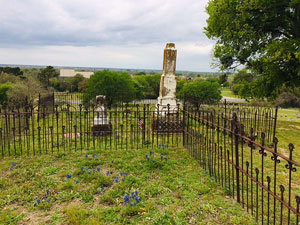 Armed with all of this information and believing that if we could find the old hill, we could find the old graves, my mother and I set out on a quest during our way up on the next race weekend. We found the secluded Fairview cemetery and were enthused at first, feeling we were so close now to being able to touch the past. Once inside and acclimated, however, we soon realized what we were up against. This wasn't some little small-scale country body park. It was still an active cemetery, as vast and massive as almost any cemetery in Houston, with rows upon rows of hills and thousands of graves for as far as the eye could see. It was going to be like finding a needle in a haystack. We quickly concluded that it would take several trips over several months before we could scan the entire grounds and decided that, at least for now, we had located the cemetery and were sure the graves were in there - somewhere.
Armed with all of this information and believing that if we could find the old hill, we could find the old graves, my mother and I set out on a quest during our way up on the next race weekend. We found the secluded Fairview cemetery and were enthused at first, feeling we were so close now to being able to touch the past. Once inside and acclimated, however, we soon realized what we were up against. This wasn't some little small-scale country body park. It was still an active cemetery, as vast and massive as almost any cemetery in Houston, with rows upon rows of hills and thousands of graves for as far as the eye could see. It was going to be like finding a needle in a haystack. We quickly concluded that it would take several trips over several months before we could scan the entire grounds and decided that, at least for now, we had located the cemetery and were sure the graves were in there - somewhere.
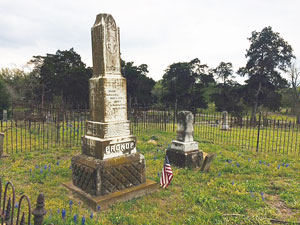 While I was searching around I recalled an interesting, somewhat disturbing paragraph I'd come across while researching online regarding early efforts by the newly formed Ladies Cemetery Association of Bastrop to improve the grounds of the aging original cemetery. From a Bastrop, Texas newspaper edition dated late April, 1885:
"A few years back, shortly after the close of the War, these grounds,
While I was searching around I recalled an interesting, somewhat disturbing paragraph I'd come across while researching online regarding early efforts by the newly formed Ladies Cemetery Association of Bastrop to improve the grounds of the aging original cemetery. From a Bastrop, Texas newspaper edition dated late April, 1885:
"A few years back, shortly after the close of the War, these grounds,
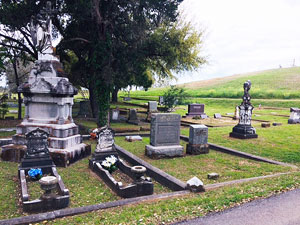 without a fence to keep (live)stock from trampling over the graves in which our dear loved ones sleep, lay neglected on a barren hill only protected by the scant vegetation which sustained a sickly existence from the poor soil, while the grinning presence of a skull, or the bony whiteness of an elbow protruded from the soil to adorn the grave of some unknown person."
without a fence to keep (live)stock from trampling over the graves in which our dear loved ones sleep, lay neglected on a barren hill only protected by the scant vegetation which sustained a sickly existence from the poor soil, while the grinning presence of a skull, or the bony whiteness of an elbow protruded from the soil to adorn the grave of some unknown person."
Feeling thwarted by the immensity of the place, we did some less effective graveside scanning by car and eventually found ourselves near a suspiciously tall, old hill fully to one side of the cemetery grounds and pointed the Mustang up a steep, red clay trail leading to the top. This was, with little doubt, the section of the cemetery described in the old newspaper. It was time to unsaddle and hunt again on foot.
The name we were searching for was Brinkman, sometimes spelled Brinkmann. While the overlooking views of the grounds back below were pastoral and pleasant, no graves of either spelling were to be found on top of the old hill. Back down we went, down into more old sections of the cemetery, the graves weathered and difficult to read. There were enough heavily stained and eroded stones and markers to keep us busy for days. We separated and I covered as much distance as fast as I could, careful not to miss any legible markers. Nearly half an hour had passed before I returned to the hill area and began wandering around behind it to where there were fewer graves but still plenty to be checked.
While admitting to myself that it wouldn't happen this trip, I really wanted to find them anyway for my mother. Even though I'd never met these Brinkmans, I realized I was silently asking them for help. As I ambled around, my pace slowing from the heat and exertion, I developed an inner dialogue with them, telling them who we were and why we had come here. I don't necessarily believe in ghosts but at the same time, I'm no Sadducceean either. If a ghost or an angel wants to believe it exists, who am I to tell it it doesn't?
I was almost lost from the car and my mother, having all but given up the search, when I happened under an old shade tree from the backside of the hill and chanced to look at a dove colored headstone that appeared too recent to be of interest. I saw the name Brinkman on it but I reasoned it must be some other Brinkman family judging by the condition of it and by the fact that there were flowers placed by it. I took a closer look, then searched the other markers around it. They were all Brinkmans - THE Brinkmans we had come here to find, all names I'd recently come to know. At that moment, I felt very calmly that they had led me to them, as I had asked.
Having not seen my mother for at least forty five minutes since we last split up, and since we were alone in the cemetery, I called out decidedly less calmly for her until we were back in hearing range and then hollered even louder - "I found them!"
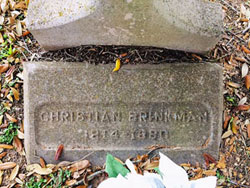
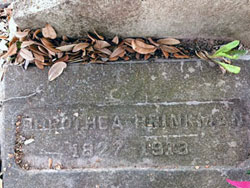 When Christian Brinkman left Westphalia at the age of 26 he was entering a Texas struggling to maintain economic solvency as a Republic under the leadership of Mirabeau B. Lamar and soon after his arrival, by Sam Houston. It is worth noting that he did not leave behind a unified Germany, political Germany at the time being made up of autonomous states of which the Province of Westphalia,
founded in its then - current iteration in 1815 was one piece of a self-governing, ever-evolving Confederation of Germany. He came over at a time when citizens of higher education were being encouraged to emigrate to America, with Westphalia being one of the regions heavily solicited by agents both from without and within. By the late 1840's a much larger wave of Westphalian immigration occurred at the urging of the German state's leaders, who envisioned future opportunities if a German enclave could be established in Texas.
When Christian Brinkman left Westphalia at the age of 26 he was entering a Texas struggling to maintain economic solvency as a Republic under the leadership of Mirabeau B. Lamar and soon after his arrival, by Sam Houston. It is worth noting that he did not leave behind a unified Germany, political Germany at the time being made up of autonomous states of which the Province of Westphalia,
founded in its then - current iteration in 1815 was one piece of a self-governing, ever-evolving Confederation of Germany. He came over at a time when citizens of higher education were being encouraged to emigrate to America, with Westphalia being one of the regions heavily solicited by agents both from without and within. By the late 1840's a much larger wave of Westphalian immigration occurred at the urging of the German state's leaders, who envisioned future opportunities if a German enclave could be established in Texas.
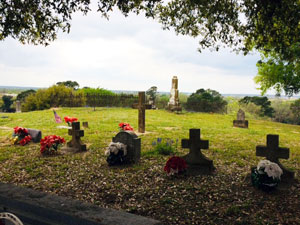 It is unknown why Christian, and later his future wife Dorothea (nee Blaser) made their decisions to make the difficult, perhaps four month long journey to Texas. Certainly, Texas seemed inviting because of the promise of religious freedom, arable land and economic independence.It could be that Christian had read a copy of "Nathan, Der Squatter", published in 1837, which, like all promotional materials of the time, painted a very idyllic picture of life in Texas. Both families were probably swayed considerably by the "American letters to Germany"; written by Johann Friedrich Ernst, a very early settler among Stephen F. Austin's original colony. As with others seeking to convince Europeans from all regions to leave their homelands for
It is unknown why Christian, and later his future wife Dorothea (nee Blaser) made their decisions to make the difficult, perhaps four month long journey to Texas. Certainly, Texas seemed inviting because of the promise of religious freedom, arable land and economic independence.It could be that Christian had read a copy of "Nathan, Der Squatter", published in 1837, which, like all promotional materials of the time, painted a very idyllic picture of life in Texas. Both families were probably swayed considerably by the "American letters to Germany"; written by Johann Friedrich Ernst, a very early settler among Stephen F. Austin's original colony. As with others seeking to convince Europeans from all regions to leave their homelands for
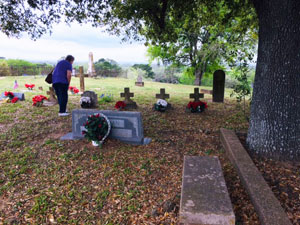 Texas, his descriptions of the new colony tended to play up the abundance of game, the fertility of the soil, the absence of a winter, and purposefully omit the negative aspects of beginning one's entire life over in such a minimally settled, untamed land. No doubt the presence of actively hostile Comanches and Cherokees was left out of the narrative. Ernst's letters were developed into a guidebook of sorts for emigrants and succeeded in bringing over large numbers of largely working class Germans from Westphalia, Holstein and Oldenburg.
Texas, his descriptions of the new colony tended to play up the abundance of game, the fertility of the soil, the absence of a winter, and purposefully omit the negative aspects of beginning one's entire life over in such a minimally settled, untamed land. No doubt the presence of actively hostile Comanches and Cherokees was left out of the narrative. Ernst's letters were developed into a guidebook of sorts for emigrants and succeeded in bringing over large numbers of largely working class Germans from Westphalia, Holstein and Oldenburg.
Ernst, who founded the first German settlement here, which he named Industry, described Texas this way:
"With enchanting scenery and delightful climate similar to that of Italy, the most fruitful soil and Republican government, with unbridled personal and political liberty, free from so many disadvantages and evils of old governments."
Having been so successfully deceived about what to expect of life in the new Republic, Christian packed such things as he felt would help further him without any real working knowledge of the daily life of a farmer in the Smithville area. He became known for his habit of wearing fine silk shirts while plowing in the fields of his new allotment of Texas land. Not because he wished to impress his fellow Texans with his stature, rather because he had brought no appropriate clothes to wear. His farm did well, did not employ slaves - many of which were concentrated on plantations - and by the time of hostilities between the states he was a well-established farmer who had made all necessary improvements to his property. One family story recounts how, during the Civil War, with troop activity from both sides high in the area, the farm was visited by a regiment of cavalry who, without asking, exchanged their spent animals horse-for-horse with fresh ones from the family stables. Desperate times called for desperate measures. It is not known if the troops were Union or Confederate.
The Brinkmans had a large family of 9 children and never were persuaded to leave Bastrop. One of them was a daughter named Emma Caroline, born in May of 1858, who would marry an Irish immigrant from Dublin named Thomas Flynn in March of 1887. This union would produce a further 8 children including a daughter, Annie Mae Flynn, who was my great grandmother.
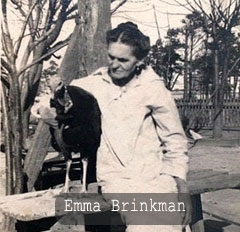
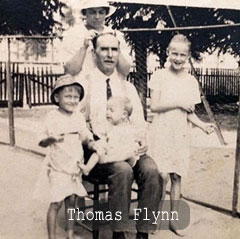
Following a deeply satisfying, long overdue meet and greet and reconciliation of the Brinkman bones under a tree at the base of the tall hill in Fairview, we headed on for Bastrop under threatening skies. It was time for Indy car racing, for getting Mario Andretti's autograph, for eating good BBQ at Southside Market and for watching a B2 stealth bomber flyover that would likely have sent all of our German ancestors shipping frantically back to Europe had they witnessed it in their day.
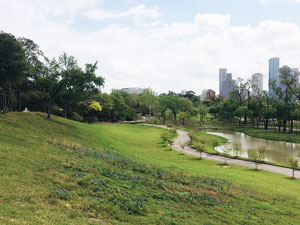 Created by an English landscape designer brought over for that purpose, the well-known Glenwood Cemetery, in view of the downtown Houston skyline, contains in its walls many of the business aristocracy responsible for creating that skyline. It is an endless maze of towering white marble and fine concrete statuary, each section more impressive than the one before it, the monuments overcrowding and seemingly overpowering each other in a way which lends a certain poetic justice to the strong, all-business personalities of their silent stockholders.
Created by an English landscape designer brought over for that purpose, the well-known Glenwood Cemetery, in view of the downtown Houston skyline, contains in its walls many of the business aristocracy responsible for creating that skyline. It is an endless maze of towering white marble and fine concrete statuary, each section more impressive than the one before it, the monuments overcrowding and seemingly overpowering each other in a way which lends a certain poetic justice to the strong, all-business personalities of their silent stockholders.
Several of the names are familiar and include much of Texas' historically significant politicians, businessmen and medical pioneers, all of whom had ties here. Howard Hughes is entombed on these grounds, as is actress Gene Tierney. Think of a Houston street name you've known of for decades and chances are the person who gave it that name is interred here. They are celebrities even in death, and their gravesites reflect this stature. Far be it from me to tell the dead how to spend their money, still, Glenwood really isn't my kind of place. It looks like an exquisite, heavily visited, energetic theme park of death, not much as a place of solitude. The markers and angelic statues teem in places with amateur photographers.
Amongst all of the impressive monuments to Houston's finest are situated, somehow, the nearly unmarked graves of Thomas and Emma Flynn. They were modest people who followed Thomas's career from Bastrop to Corpus Christi and then to Houston where he worked for years as a cotton grader and then as a rice grader. Their success was not one of grand scale by any means. By cotton-grader standards, to borrow the lingo, it was fair to middling. Thomas died in 1926 at 68 years of age and Emma lived until 1934 and died at 75 years of age. My mother was not yet born when Emma died and had only visited the gravesite with family as a very young child. Overall our likelihood of success in finding their graves was not feeling much better than it had in Bastrop.
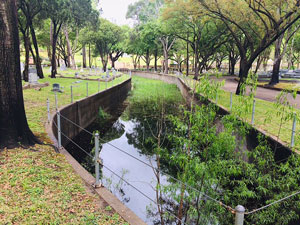 Our only clue, as my mother somehow recalled, was that the gravesite was near a long drainage culvert, or waterway of some kind.She recollected that she and her brothers had played near it on their few visits nearly seventy years ago. Once inside the pillared gates we began attempting to orient ourselves, slowly driving along the grounds and discovering things had changed over time.
Our only clue, as my mother somehow recalled, was that the gravesite was near a long drainage culvert, or waterway of some kind.She recollected that she and her brothers had played near it on their few visits nearly seventy years ago. Once inside the pillared gates we began attempting to orient ourselves, slowly driving along the grounds and discovering things had changed over time. 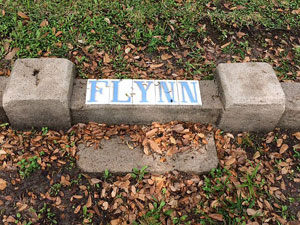 There seemed to be walls where there weren't walls before. The structural layout seemed different than my mother remembered. Perhaps the drainage culvert was no longer there, replaced by underground drainage technology, space being at quite a literal premium. The situation was beginning to again appear bleak, however we "failed in our efforts to give up" as they say, and eventually the culvert appeared in the near distance. We picked our way over on narrow roads and began the search.
There seemed to be walls where there weren't walls before. The structural layout seemed different than my mother remembered. Perhaps the drainage culvert was no longer there, replaced by underground drainage technology, space being at quite a literal premium. The situation was beginning to again appear bleak, however we "failed in our efforts to give up" as they say, and eventually the culvert appeared in the near distance. We picked our way over on narrow roads and began the search.
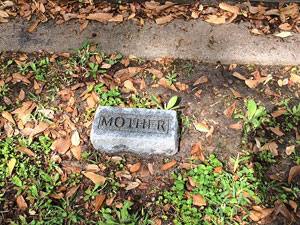 Not far away we came to a flat, curbed plot of ground, unadorned and identified only by a few blue and white lettered tiles spelling out "Flynn." There were no headstones or name plaques on either grave, merely two small, very modest grey granite markers reading "MOTHER" and "FATHER."
Not far away we came to a flat, curbed plot of ground, unadorned and identified only by a few blue and white lettered tiles spelling out "Flynn." There were no headstones or name plaques on either grave, merely two small, very modest grey granite markers reading "MOTHER" and "FATHER." 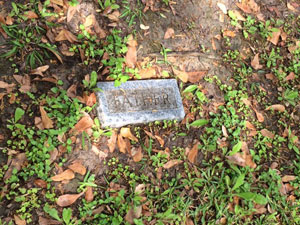 This was likely all the family could afford as the country dealt with the Great Depression. At the time it was enough just for the generation of descendants they had created to know who they were. Yet here is where they have laid in peace for all of these years, and even though their graves may fail to impress their neighbors, or anyone other than family, I was deeply satisfied to have found them, and felt an important connection with them for the first time. As with the Brinkmans, it seemed appropriate to introduce ourselves since we were, afterall, otherwise strangers except by blood. They may well have considered themselves lost to time many decades ago. Because of my mother's flawless memory however - a Flynn family trait - they hadn't been. The Flynns should expect us back at Christmastime with poinsettias.
This was likely all the family could afford as the country dealt with the Great Depression. At the time it was enough just for the generation of descendants they had created to know who they were. Yet here is where they have laid in peace for all of these years, and even though their graves may fail to impress their neighbors, or anyone other than family, I was deeply satisfied to have found them, and felt an important connection with them for the first time. As with the Brinkmans, it seemed appropriate to introduce ourselves since we were, afterall, otherwise strangers except by blood. They may well have considered themselves lost to time many decades ago. Because of my mother's flawless memory however - a Flynn family trait - they hadn't been. The Flynns should expect us back at Christmastime with poinsettias.
Barely a few miles away by car, a world apart though from the pomp and circumstance of Glenwood, we arrived later that day at the last of the old ancestral graveyards. The Eichwurzel family cemetery is one of the smallest private cemeteries in the city of Houston. It is literally nothing more than a number of slightly scattered graves on an undeveloped lot of land in a near-town neighborhood which patiently awaits transition. The cemetery lawn and some of the acreage surrounding it, were once owned by Johannn Wilhelm Eichwurzel, Sr. An immigrant from Kristianstad, Sweden, Johann left his native country from Skane one month after marrying a young German woman named Johanna Sophie Maria Schmidt and arrived along with her at the port of New Orleans on Halloween Day, 1871.
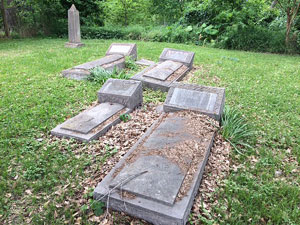 Sweden, for somewhat different reasons than Germany, seemed equally motivated to rid itself of some of the perceived lower classes in a monarchial society which had traditionally been rigidly class-tiered. From those who desired to get away from Sweden, their reasons were much the same as they had been for many other European countries. Religious oppression, a lack of economic opportunity and numerous crop failures cultivated the desire to start once again in a better place. The shipping lines courted Swedish immigrants, making it more affordable and less of a hardship for lower class Swedes to leave. As it had always been, America - of which Texas was now a member state - was described as a land of plenty. Now, unlike in times past, there really was some validity in this claim, at least for certain regions of the country as the Industrial Revolution gained momentum. The number of Swedes leaving by the end of the 1860's to escape the Great Deprivation amounted to a near mass exodus and the class-dependent Swedish economy soon found itself wanting for unskilled farm labor as the workforce was in some areas becoming rapidly depleted. With an industrializing America also in need of farmers as big cities continued to lure people from the farmlands, there was plenty to tempt a struggling Swede into the water for the three month trip.
Sweden, for somewhat different reasons than Germany, seemed equally motivated to rid itself of some of the perceived lower classes in a monarchial society which had traditionally been rigidly class-tiered. From those who desired to get away from Sweden, their reasons were much the same as they had been for many other European countries. Religious oppression, a lack of economic opportunity and numerous crop failures cultivated the desire to start once again in a better place. The shipping lines courted Swedish immigrants, making it more affordable and less of a hardship for lower class Swedes to leave. As it had always been, America - of which Texas was now a member state - was described as a land of plenty. Now, unlike in times past, there really was some validity in this claim, at least for certain regions of the country as the Industrial Revolution gained momentum. The number of Swedes leaving by the end of the 1860's to escape the Great Deprivation amounted to a near mass exodus and the class-dependent Swedish economy soon found itself wanting for unskilled farm labor as the workforce was in some areas becoming rapidly depleted. With an industrializing America also in need of farmers as big cities continued to lure people from the farmlands, there was plenty to tempt a struggling Swede into the water for the three month trip.
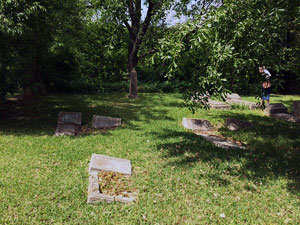 Most Swedes, once here, settled in the North or on the Plains where the climate was familiar and more tolerable than in the Southern states. Settlements in Minnesota grew as fast as the ships could offload their human cargo. Very few Swedes sought to stake claims in the subtropical swamps of the Deep South. As a skilled carpenter, Johann Eichwurzel found a strong demand for his labor here. As of 1880, he and Sophie were two of only 364 Swedes living in Texas. Once settled here, he eventually founded - and likely helped build - White Oak Methodist Church on land near his residence, a church which he, now a reverend, presided over. Johann - known as John in the states - lays at rest here along with his wife Sophie. The family they established has many branches, a few of which, the Sharman and the Darling families, also reside here in eternity.
Most Swedes, once here, settled in the North or on the Plains where the climate was familiar and more tolerable than in the Southern states. Settlements in Minnesota grew as fast as the ships could offload their human cargo. Very few Swedes sought to stake claims in the subtropical swamps of the Deep South. As a skilled carpenter, Johann Eichwurzel found a strong demand for his labor here. As of 1880, he and Sophie were two of only 364 Swedes living in Texas. Once settled here, he eventually founded - and likely helped build - White Oak Methodist Church on land near his residence, a church which he, now a reverend, presided over. Johann - known as John in the states - lays at rest here along with his wife Sophie. The family they established has many branches, a few of which, the Sharman and the Darling families, also reside here in eternity.
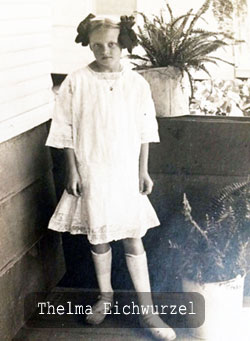 While things had changed greatly from the early 1840's, times were not easy by any means in Texas even at the turn of the century. The Eichwurzel family was devastated by a flu epidemic of 1907, which took the lives of two year old Clarence Eichwurzel, his mother Stella (nee Darling) Eichwurzel and her mother in law, our Sophie Eichwurzel of Germany via Sweden, who was 60 years old at the time. Husband Johann, with whom she had a son named Johann, Jr. - my great grandfather - lived to be over 100 years old, nearly unheard of for a man of that era. John Jr. - or Ikey as he was known to us - would in time seek the hand of Annie Mae Flynn. Their daughter, Thelma Ethel, would be born in 1907, would contract diphtheria in the late winter months of 1909 and would somehow survive while Harvey Sharman, her cousin of nearly the same age, would not.
While things had changed greatly from the early 1840's, times were not easy by any means in Texas even at the turn of the century. The Eichwurzel family was devastated by a flu epidemic of 1907, which took the lives of two year old Clarence Eichwurzel, his mother Stella (nee Darling) Eichwurzel and her mother in law, our Sophie Eichwurzel of Germany via Sweden, who was 60 years old at the time. Husband Johann, with whom she had a son named Johann, Jr. - my great grandfather - lived to be over 100 years old, nearly unheard of for a man of that era. John Jr. - or Ikey as he was known to us - would in time seek the hand of Annie Mae Flynn. Their daughter, Thelma Ethel, would be born in 1907, would contract diphtheria in the late winter months of 1909 and would somehow survive while Harvey Sharman, her cousin of nearly the same age, would not.
Unfortunately, some of the grave markers from this cemetery, which sits near the banks of an unimproved section of White Oak Bayou, have been lost over the years to flooding. There are more bodies, some related some not, buried under the ground than there are graying headstones to tell us who they were. It is remarkable that these old graves, both in Bastrop and here in a small yard on Enid Street, still exist, and it is important that they - and others like them - still do. It is only by visiting them that we can truly form a sense of knowing to whose bones we belong.
Let us know what your favorite things to do or places to go were when you were younger. Go to the CONTACT US page and email the information or any comment you have about the trips that have been featured. We always want to hear from our friends and neighbors!